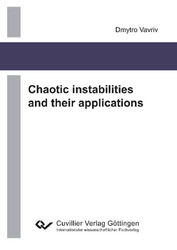| Fachbereiche | |
|---|---|
| Buchreihen (96) |
1378
|
| Nachhaltigkeit |
3
|
| Gesundheitswesen |
1
|
| Geisteswissenschaften |
2365
|
| Naturwissenschaften |
5406
|
| Ingenieurwissenschaften |
1793
|
| Allgemeine Ingenieurwissenschaften | 292 |
| Maschinenbau und Verfahrenstechnik | 862 |
| Elektrotechnik | 686 |
| Bergbau- und Hüttenwesen | 30 |
| Architektur und Bauwesen | 75 |
| Allgemein |
98
|
|
Leitlinien Unfallchirurgie
5. Auflage bestellen |
|
Erweiterte Suche
Chaotic instabilities and their applications
Dmytro Vavriv (Autor)Vorschau
Inhaltsverzeichnis, Datei (46 KB)
Leseprobe, Datei (82 KB)
The phenomenon of chaos, which is arising as noise-like oscillations in deterministic low-dimensional nonlinear system–s, should be treated from two different points of view. First, this effect can create a threat to stability of many practical systems, and it is needed to know conditions for the chaos to arise. Second, chaotic oscillations can be used for the development of various advanced devices, like noise oscillators, random number generators, noise radars, and so on. Both mentioned directions of the chaos study are addressed in this thesis.
In this thesis, we present a first attempt to study chaotic instabilities which arise during the transition of pulses via nonlinear circuits. The mathematical model used is a generalized Duffing equation, which is an adequate model to describe stability in a number of electronic, microwave, and optical devices. The simplest physical oscillator which is described by such equation is a RLC-circuit with nonlinear capacitor, or a cavity with nonlinear element or media.
Analytical, numerical, and experimental methods have been used in order to determine conditions for chaotic instabilities arising. For example, the application of secondary averaging has enabled us to find resonances which can give rise to chaotic instabilities, and to determine analytical conditions for chaos onset. These conditions have been compared with those obtained from numerical simulations and experimental investigations, and a good correspondence of the obtained results has been detected. The experiments have been performed with a nonlinear RLC circuit forced by a train of RF-pulses with rectangular envelope and with carrier frequency of about 30 MHz.
The obtained results indicate that weakly nonlinear oscillators which are stable under harmonic forcing can lose their stability when a train of pulses is applied. The development of the chaotic instabilities takes place due to the interaction of spectral components of the pulse train. It is shown that there is a certain relation between the pulse duration and the pulse period when the threshold for chaos with respect to pulse intensity reaches a minimum value. This value is also lowering with reduced losses in the system and with increased the period of modulation and the nonlinearity parameter.
The second part of the thesis is devoted to the application of chaotic oscillations for the development of reliable sources of random sequences. We have presented a proof that chaotic oscillations generated by some nonlinear systems can be used to produce random binary sequences. These sequences pass the tests specified by the US Standard FIPS PUB 140-1/140-2, and this means that they are suitable for cryptographic applications. Generators of random sequences based on deterministic systems with chaotic behaviour, like physical noise sources, can generate truly random sequences in opposite to software generators, which produce pseudorandom cycle samples.
We have also determined regularities of the formation of chaotic oscillations, which can be used for the production of random binary sequences. In particular, it has been detected that the areas of existence of chaotic oscillations in the control parameter space are wider as compared to those areas, where random sequences are produced. Hence, not any chaos generation scheme can be used for the production of random sequences. Moreover, it turned out that not any dynamical system with chaotic behavior is suitable for this purpose. For example, the forced pendulum generates sequences which do not pass the tests for randomness. The most possible reason for not passing the tests is related with the presence of intensive spectral components in the power spectrum. However, the presented results of the study of the Lorenz equations and a pendulum equation with delay as well as the Mackey-Glass equation indicate that it is possible to find dynamical systems with chaotic behavior, which generate random sequences in wide areas of their control parameters. The obtained results clearly indicate that deterministic systems with chaotic behavior can be used as generators of random sequences combining the advantages of software random generators and physical noise sources.
| ISBN-13 (Printausgabe) | 3869551593 |
| ISBN-13 (Printausgabe) | 9783869551593 |
| ISBN-13 (E-Book) | 9783736931596 |
| Buchendformat | A5 |
| Sprache | Englisch |
| Seitenanzahl | 94 |
| Umschlagkaschierung | matt |
| Auflage | 1 Aufl. |
| Band | 0 |
| Erscheinungsort | Göttingen |
| Promotionsort | TU Hamburg-Harburg |
| Erscheinungsdatum | 18.11.2009 |
| Allgemeine Einordnung | Dissertation |
| Fachbereiche |
Maschinenbau und Verfahrenstechnik
|








